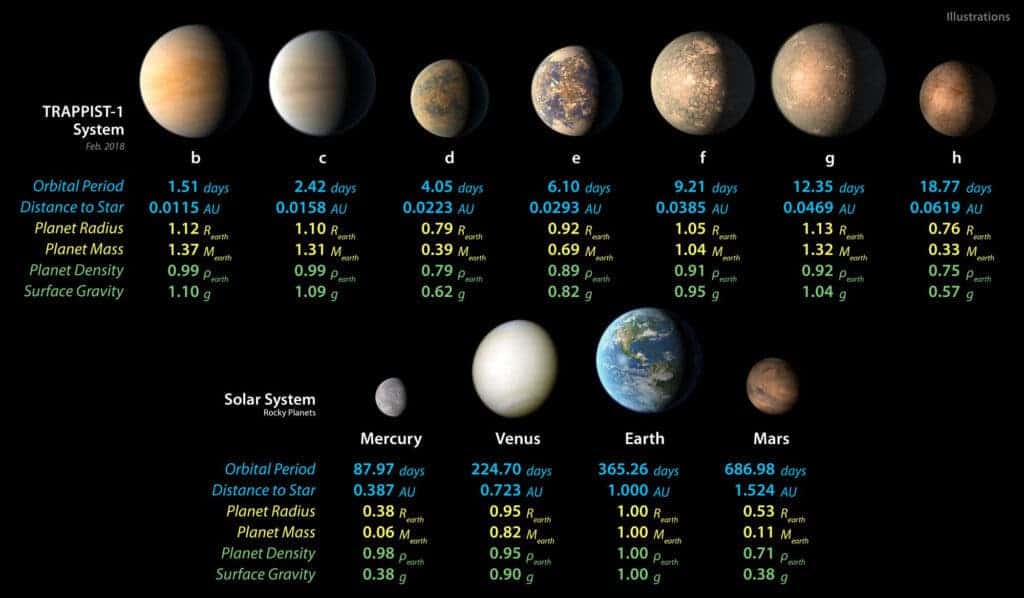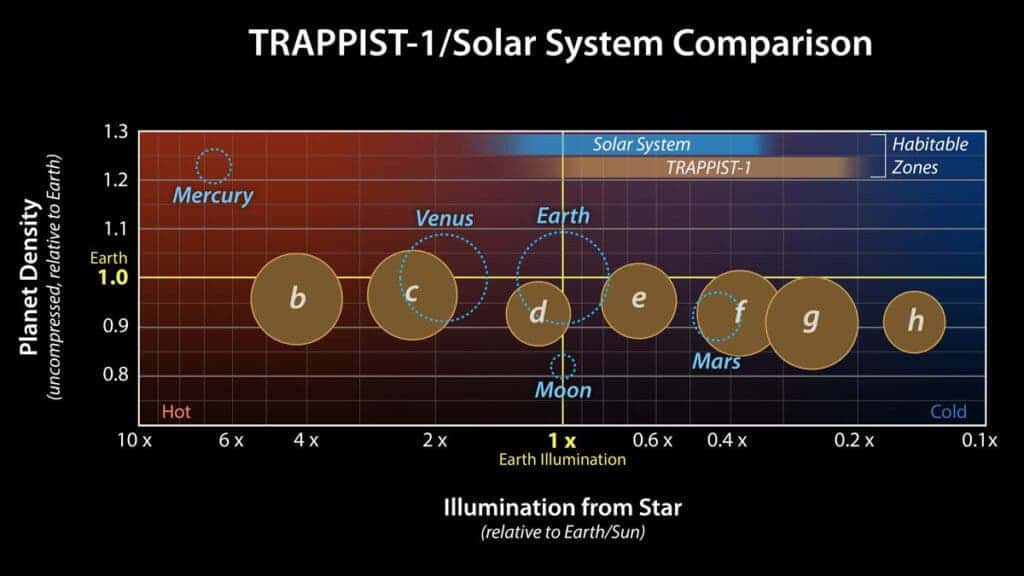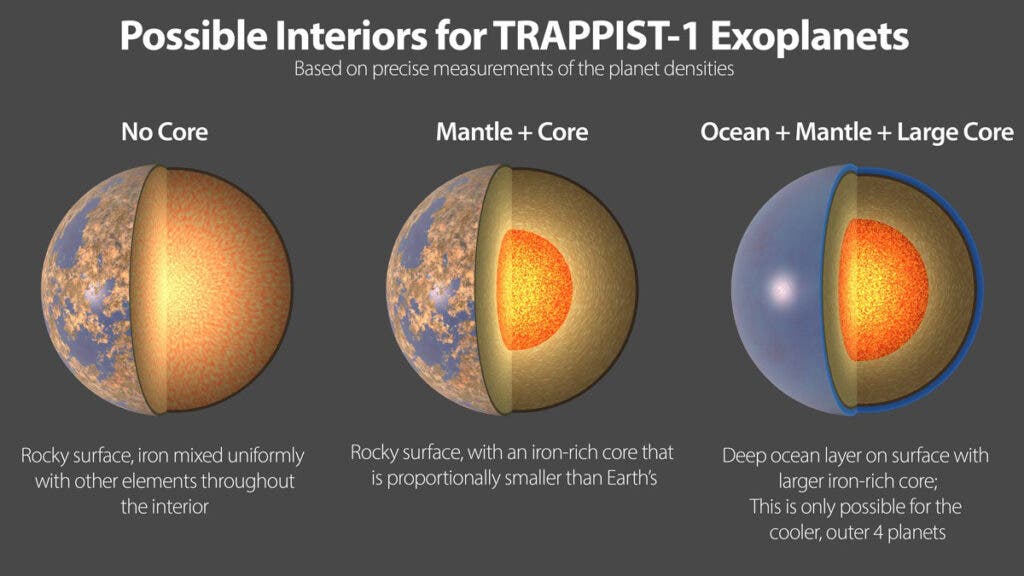The star system of Trappist-1 is home to the largest group of Earth-like planets ever discovered elsewhere in the Universe by astronomers. This means that investigating these seven rocky worlds gives us a good idea of how common exoplanets with similar compositions to our own are in the Milky Way and the wider cosmos.
New research has revealed that these planets, which orbit the Trappist-1 star 40 light-years away from Earth, all have remarkably similar compositions and densities. Yet, all are less dense than Earth.
The results could indicate these are worlds with much more water than is found on earth, or possibly even that these planets are composed almost entirely of rust.

This similarity between the exoplanets makes the Trappist-1 system significantly different from our own solar system which consists of planets with radically compositions and densities. Trappist-1’s worlds are dense, meaning they are like the rocky planets in our solar system, Earth, Mars, Venus, and Mercury. The system seems to be lacking larger gas dominated planets like Jupiter, Saturn, Uranus and Neptune.
The finding, documented in a paper published in the Planetary science Journal shows how the system, first discovered in 2016, offers insight into the wide variety of planetary systems that could fill the Universe.

“The new observations allowed us to use transit data from a much longer time span than was available to us for the 2018 calculations,” explains Simon Grimm of the University of Bern, who as well as being involved in the current study, was part of a 2018 team that provided the most accurate calculation of the masses of the seven planets thus far. “With the new data, we were able to refine the mass and density determinations of all seven planets.
“It turned out that the derived densities of the planets are even more similar than we had previously expected.”
Seven Exoplanets with Similar Densities
The similarity in densities observed in the Trappist-1 exoplanets seen by the astronomers hailing from the Universities of Bern, Geneva and Zurich, indicates that there is a good chance they are composed of the same materials at similar ratios.
These are the same materials that we believe form most terrestrial planets, iron, oxygen, magnesium, and silicon. But there is a significant difference between our terrestrial world and the Trappist-1 exoplanets.

The planets in the Trappist-1 system appear to be about 8% less dense than the Earth. This suggests that the materials that comprise them exist in different ratios than they do throughout our home planet.
This difference in density could be the result of several different factors.
One of the possibilities being investigated by the team is that the surfaces of the Trappist-1 exoplanets could be covered with water, reducing their overall density. Combining the planetary interior models with the planetary atmosphere models, the team was able to evaluate the water content of the seven TRAPPIST-1 planets with what Martin Turbet, an astrophysicist at the University of Geneva and co-author of the study describes as “a precision literally unprecedented for this category of planets.”
For the Trappist-1 system’s four outermost planets, should water account for the difference in density, the team has estimated that water would account for 5% of their overall masses. This is considerably more than the 0.1% of Earth’s total mass made up of water.
Rust Nevers Sleeps for the Trappist-1 Planets
Another possibility that could explain why the Trappist-1 exoplanets have lower densities than Earth is the fact that they could be composed of less iron than our planet is–21% rather than the 32% found in the Earth.
It’s also possible that the iron within the seven exoplanets could be bonded with oxygen forming iron oxides–commonly known as rust. This additional oxygen would reduce the planet’s densities.

Iron oxides give Mars its rust-red colour, but they are pretty much confined to its surface. Its core is comprised of non-oxidized iron like the solar system’s other terrestrial planets. If iron-oxide accounts for the seven exoplanet’s lower densities it implies that these worlds are rusty throughout and lacking solid non-oxidized iron cores.
“The lower density might be caused by a combination of the two scenarios – less iron overall than and some oxidized iron,” explains Eric Angol, an astrophysicist at the University of Washington and lead author of the new study. “They might contain less iron than Earth and some oxidized iron like Mars.”
Angol also points out that the Trappist-1 planets are likely to have a low-water content, an idea supported by previous research. “Our internal and atmospheric structure models show that the three inner planets of the TRAPPIST-1 system are likely to be waterless and that the four outer planets have no more than a few per cent water, possibly in liquid form, on their surfaces,” says Turbet.
This seems to favour the theory that the lower density of the Trappist-1 planets is a result of one or both of the iron scenarios suggested by the researchers.
There’s Still a Lot to Learn from Trappist-1
Since its discovery in 2o16, the Trappist system has been the subject of a wealth of observations made by both space and ground-based telescopes alike. Before it was decommissioned at the start of January 2020 the team used the Spitzer Space Telescope to collect their data. This telescope, operated by NASA’s Jet Propulsion Laboratory, alone has clocked in more than 1,000 hours of targeted observations of the exoplanets.
This new study demonstrated the importance of studying systems such as Trappist-1 for extended periods of time.
Caroline Dorn, an astrophysicist at the University of Zurich also highlights the fact that studying systems like this could answer questions about the habitability of exoplanets and the possibility of life elsewhere in the Universe.
“The TRAPPIST-1 system is fascinating because around this one star we can learn about the diversity of rocky planets within a single system,” concludes Dorn. “And we can actually learn more about an individual planet by studying its neighbours as well, so this system is perfect for that.”
“The night sky is full of planets, and it’s only been within the last 30 years that we’ve been able to start unravelling their mysteries, also for determining the habitability of these planets.”
Original Research
Agol. E., Dorn. C., Grimm. S. L., et al, ‘Refining the transit timing and photometric analysis of TRAPPIST-1: Masses, radii, densities, dynamics, and ephemerides,’ Planetary Science Journal, [https://arxiv.org/abs/2010.01074]


